Mystical cherubim in biblical imagery reveal layers of divine symbolism, enticing readers to explore their profound spiritual and artistic significance.
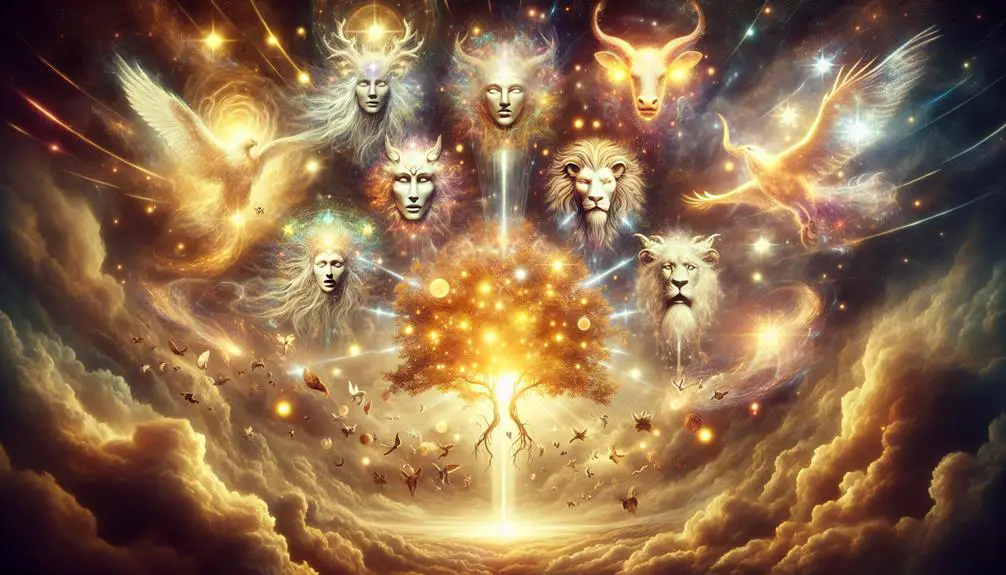
Pictures of Cherubim in the Bible
Cherubim captivate with their celestial charm, creating a compelling cornerstone of biblical iconography that you've likely encountered. These enigmatic entities, though often depicted with wings and youthful innocence, embody a depth of spiritual symbolism that transcends their visual representations.
As you explore the origins of Cherubim imagery and their evolution through sacred texts, artistic renditions, and modern interpretations, you'll uncover layers of meaning that might challenge your initial perceptions. This journey promises to illuminate not only the historical and cultural significance of these divine figures but also their enduring influence on contemporary spirituality and art.
Why are these heavenly beings so pivotal, and what secrets do their images hold?
Key Takeaways
- Cherubim imagery in the Bible is influenced by ancient Near Eastern civilizations.
- They are depicted as guardians of sacred spaces and convey divine majesty.
- Artistic representations of Cherubim have evolved across different eras, reflecting cultural interpretations.
- Cherubim symbolize divine protection and the connection between the divine and earthly realms.
Origins of Cherubim Imagery
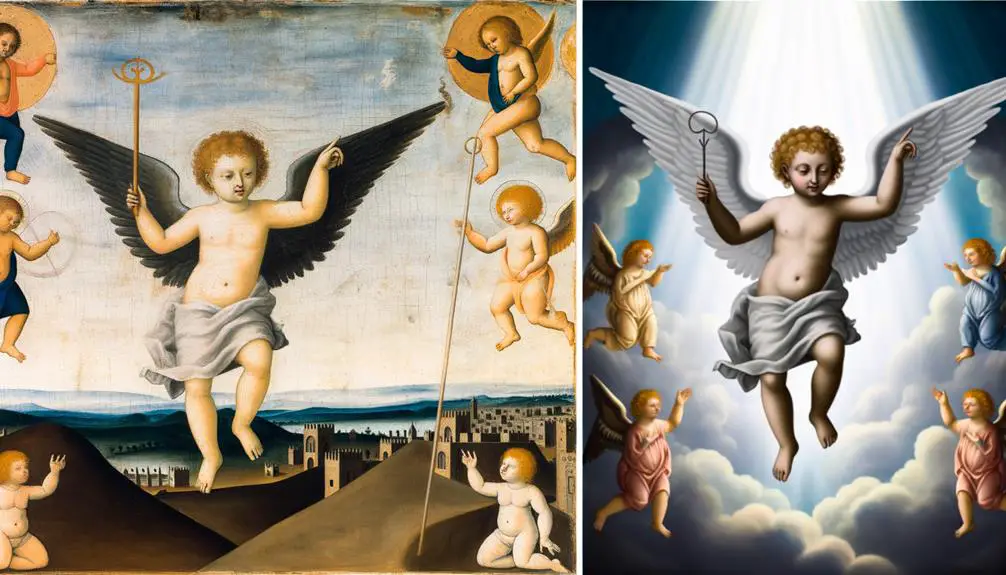
The origins of Cherubim imagery in the Bible can be traced back to ancient Near Eastern civilizations, where these celestial beings were first conceptualized as guardians of sacred spaces. You'll find that the concept of Cherubim isn't isolated to the Hebrew Bible; instead, it's deeply rooted in the rich tapestry of cultural influences and mythological parallels that span across Mesopotamia, Egypt, and Canaan.
These cultures, flourishing with their own pantheons and spiritual entities, provided a fertile ground for the development of Cherubim imagery, blending their characteristics into a unique representation that found its place in the Hebrew biblical tradition.
Analyzing these cultural influences, you'll notice that Cherubim share similarities with the lamassu of Assyria and Babylon—mythical creatures with bodies of bulls or lions, wings of eagles, and human heads, designed to protect and ward off evil. This cross-pollination of ideas reflects the interconnectedness of ancient Near Eastern societies, where trade, conquest, and communication facilitated the exchange of religious and mythological concepts.
Furthermore, the adaptation of these mythological parallels into the Hebrew Bible exemplifies a process of syncretism, where foreign influences were assimilated and recontextualized within a monotheistic framework. This process wasn't merely imitation but a deliberate effort to imbue Cherubim with a theological significance that aligned with the emerging Israelite identity and religious beliefs.
In essence, the Cherubim's imagery in the Bible is a testament to the complex interplay of cultural influences and mythological parallels, showcasing how ancient civilizations borrowed from and influenced each other's spiritual landscapes.
Cherubim in Sacred Texts
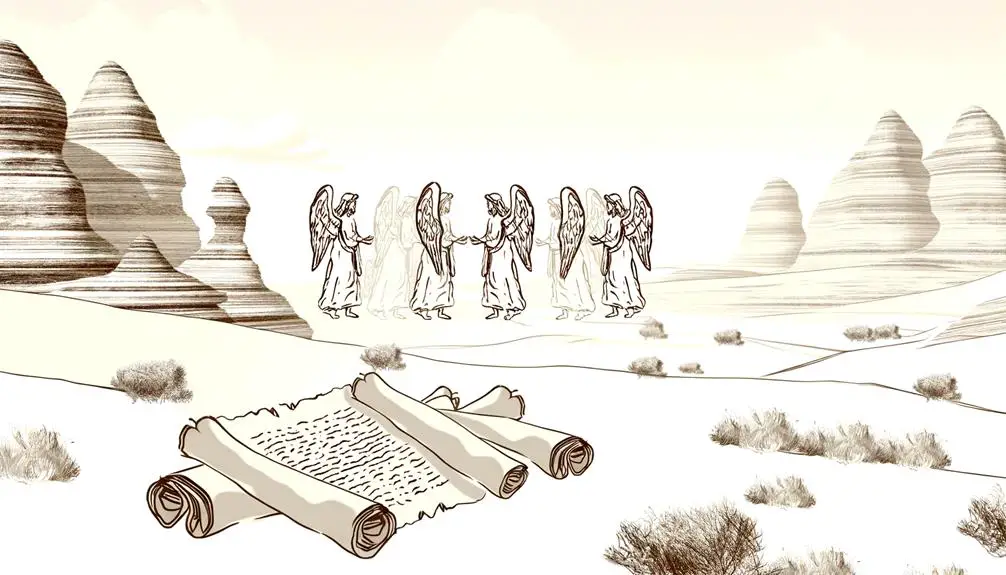
Delving into sacred texts, you'll find that Cherubim play a pivotal role in the narrative and theological fabric of the Hebrew Bible, embodying divine protection and presence. These celestial beings aren't merely decorative; they're deeply embedded within the structure of Biblical narratives, serving multifaceted functions that reflect their significance in ancient Near Eastern theology.
Cherubim descriptions in the Bible aren't uniform, suggesting a complex and evolving conception of these entities. In some instances, they're depicted as fearsome guardians; in others, as vehicles of divine majesty. For example, in the Book of Genesis, Cherubim guard the way to the Tree of Life, a clear symbol of their protective role. Conversely, in the Book of Ezekiel, they're described with multiple faces, wings, and eyes, signifying their omnipresence and omniscience, attributes that underscore their connection to the divine.
The construction of the Ark of the Covenant, as detailed in the Book of Exodus, further illustrates the Cherubim's integral role. Positioned on the Mercy Seat, their wings outstretched, they not only symbolize God's throne but also His immediate presence among His people. This imagery reinforces the notion of Cherubim as intermediaries between the divine and the earthly realms.
Biblical narratives thus utilize Cherubim descriptions to convey themes of divine protection, presence, and transcendence. Their depiction across various texts highlights their enduring significance within the religious and cultural psyche of ancient Israel, serving as a testament to their multifaceted role within sacred literature.
Symbolism and Significance
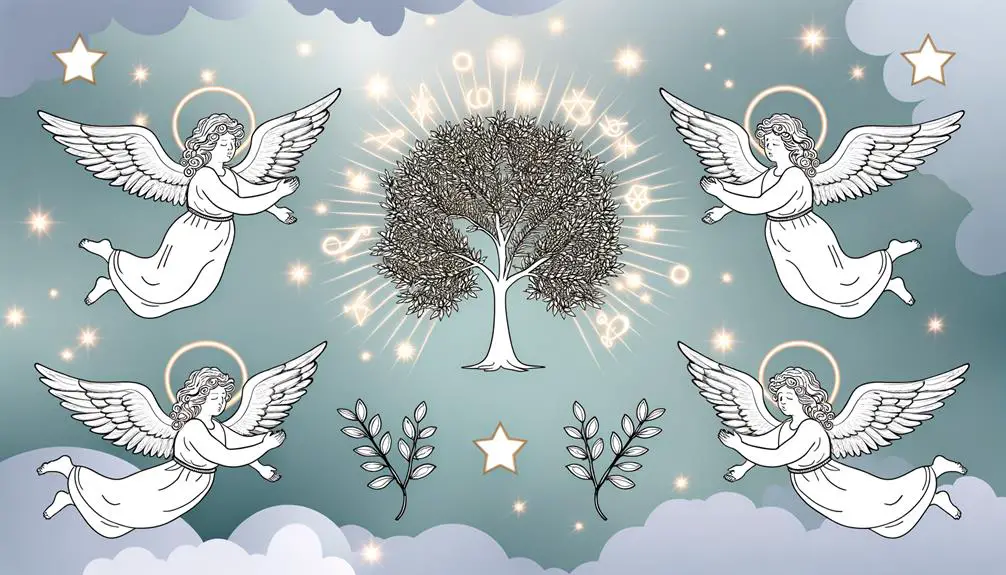
Exploring the symbolism and significance of Cherubim reveals their profound impact on theological concepts and religious practices in ancient Israel. These celestial beings, often depicted as part human and part animal, serve as a bridge between the divine and the earthly, embodying the complexities of divine guardianship and sanctity. Their guardian roles are not merely symbolic but function within the worship context, reinforcing the sacredness and holiness of spaces regarded as divine.
The table below outlines key aspects of Cherubim symbolism and significance:
Aspect |
Description |
Context |
|---|---|---|
Guardian Roles |
Cherubim are depicted as guardians of sacred spaces, embodying divine protection. |
This role is evident in their placement at the entrance of the Garden of Eden and the Holy of Holies. |
Worship Context |
Their presence in the Tabernacle and Solomon's Temple underlines their integral role in worship practices and rituals. |
These settings highlight the Cherubim's role in creating a sacred space for divine-human interaction. |
Theological Symbolism |
Cherubim represent God's omnipresence and omniscience, serving as symbols of divine authority and power. |
Their depiction emphasizes the transcendence and immanence of God in the lives of the faithful. |
In understanding the symbolism and significance of Cherubim, you're delving into the heart of ancient Israelite religious identity and practice. Their guardian roles and presence within the worship context underscore their importance in maintaining the sanctity of holy spaces and facilitating a closer connection to the divine. This exploration offers a glimpse into the profound spiritual and theological underpinnings of these celestial beings in the biblical narrative.
Artistic Representations Throughout History
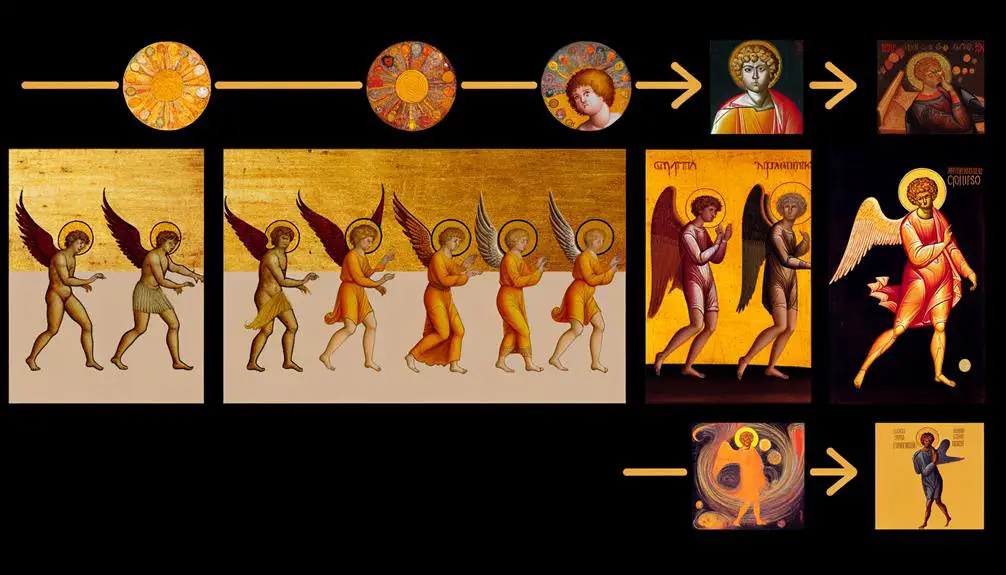
Throughout history, artists have vividly depicted Cherubim in a myriad of forms, reflecting their evolving interpretation and significance within religious and cultural contexts. The artistic representations of Cherubim are as varied as the cultures that interpret these celestial beings. From the ancient walls of Mesopotamian palaces to the stained glass of Gothic cathedrals, each era and region have brought their unique perspective and artistic techniques to bear on the depiction of Cherubim.
Cultural variations in the portrayal of Cherubim highlight the diverse ways in which these beings have been understood and revered. In some traditions, Cherubim are depicted with multiple faces and wings, embodying attributes of the divine, while in others, they take on a more human-like appearance, serving as a bridge between the divine and the earthly. This richness of interpretation underscores the complexity of Cherubim as symbols within various religious and cultural narratives.
The artistic techniques employed in the depiction of Cherubim also reveal much about the times and places in which these works were created:
- Frescoes and mosaics in early Christian and Byzantine art utilized color and form to convey the ethereal and transcendent nature of Cherubim.
- Sculpture during the Renaissance period emphasized physical form and detail, grounding Cherubim in a more tangible reality.
- Painting across different eras has captured the subtlety of Cherubim's divine nature through the interplay of light, shadow, and color.
These artistic representations not only illustrate the evolution of religious thought and cultural aesthetics but also invite viewers to contemplate the deeper meanings and mysteries embodied by Cherubim.
Modern Interpretations and Influence
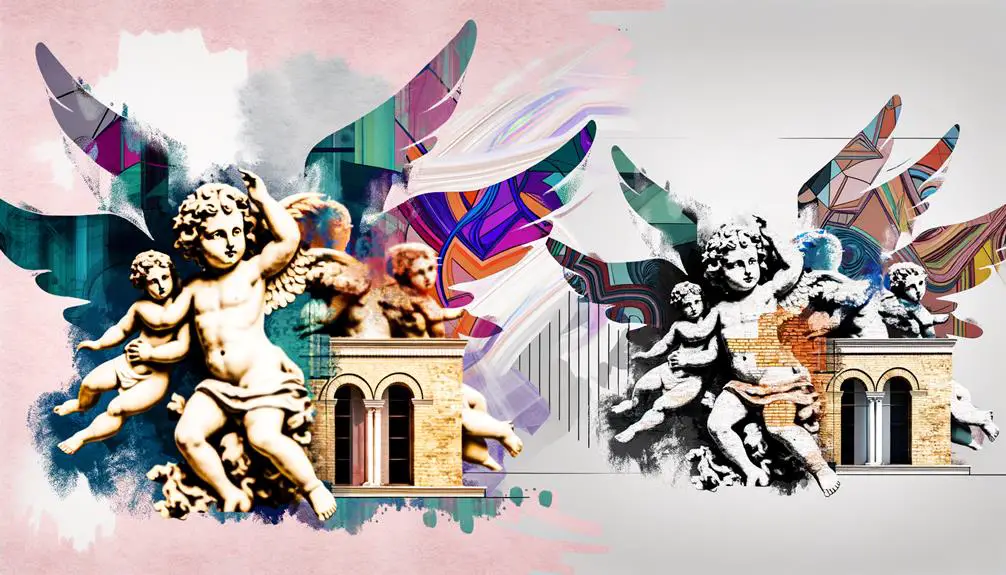
Building on the historical and artistic foundations, we now examine how Cherubim's portrayals have evolved in modern contexts, reflecting contemporary spiritual and cultural influences. Initially, Cherubim's representations were predominantly rooted in religious texts and iconography, meticulously adhering to descriptions found within the Bible. However, as you delve deeper into the current era, a significant transition becomes evident. Cherubim have transcended their strictly biblical origins, permeating various facets of pop culture and digital art, demonstrating a remarkable adaptability to the evolving tastes and sensibilities of society.
You'll notice that pop culture references to Cherubim often diverge from traditional imagery, instead opting for interpretations that blend ancient symbols with modern aesthetics. Films, literature, and music frequently utilize Cherubim motifs, sometimes preserving their sacredness, but often reimagining them with a contemporary twist. This fusion emphasizes the enduring relevance of these celestial beings, showcasing their ability to inspire across epochs.
Simultaneously, digital artwork trends have ushered in a new era for Cherubim representations. Artists now harness cutting-edge technology to reimagine these entities, blending historical accuracy with imaginative flair. You'll find digital illustrations that vary from hyper-realistic to abstract, each artist's interpretation contributing to a diverse tapestry of Cherubim imagery. This digital renaissance not only broadens the scope of their depiction but also democratizes their creation, allowing a wider range of voices to partake in their visual evolution.
In this modern landscape, Cherubim serve as a bridge between the sacred and the secular, their images continuously reshaped by the currents of contemporary culture. This dynamic interplay highlights their enduring significance and adaptability, ensuring their place in both spiritual realms and pop culture panoramas.
Frequently Asked Questions
How Do the Descriptions of Cherubim Vary Across Different Religious Traditions Outside of Christianity and Judaism?
You'll find that cherubim descriptions vary significantly outside of Christianity and Judaism.
In Islamic interpretations, cherubim aren't depicted visually but are often described as beings of light and spirituality, reflecting Islamic art's aniconic tradition.
Meanwhile, Hindu symbolism doesn't directly correspond to cherubim, but similar celestial beings like apsaras or devas share traits of guardianship and divinity, showcasing a broad spectrum of divine representation across cultures.
Are There Any Notable Examples of Cherubim Imagery Found in Unexpected Places or Cultures That Are Not Commonly Associated With Abrahamic Religions?
You'll find cherubim imagery in unexpected places, reflecting art influences and cultural fusion far beyond their Abrahamic origins.
These symbols have traversed cultural boundaries, popping up in locations and traditions not typically associated with their religious roots.
This cross-cultural presence underscores the deep impact of religious iconography on global art forms, demonstrating a fascinating blend of belief systems and aesthetic values that challenge the conventional understanding of sacred symbols.
Have There Been Any Significant Controversies or Debates Regarding the Depiction of Cherubim in Religious or Public Spaces?
Yes, there have been significant controversies surrounding the depiction of cherubim in various spaces.
These debates often stem from artistic liberties taken, leading to an iconographic evolution that doesn't always align with traditional views.
You'll find that as artists interpret these beings, their renditions can spark discussions on religious accuracy vs. creative expression.
This tension highlights the delicate balance between preserving sacred imagery and allowing for artistic interpretation.
How Have Interpretations of Cherubim Changed in Popular Media, Such as Movies, Literature, and Video Games, Compared to Traditional Religious Texts?
In modern media, you'll find cherubim symbolism and interpretations vastly different from traditional texts. Whereas once cherubim were depicted as majestic, fearsome creatures, today's portrayals often lean towards cute, infantile figures, especially in movies and literature.
This shift reflects broader changes in how society views the divine and the supernatural. Video games, in particular, have embraced this transformation, presenting cherubim in various imaginative roles that diverge significantly from their biblical origins.
Can the Concept of Cherubim Be Found in Any Scientific or Psychological Theories, and if So, How Is It Interpreted or Used in Those Contexts?
You're chasing rainbows if you're looking for cherubim in scientific theories. However, in the realm of psychology, cherubim symbolism finds its footing. They're seen through the lens of psychological archetypes, embodying innocence or protection in the collective unconscious.
This interpretation diverges from religious texts, applying cherubim symbolism to explore human psyche depths. Such usage highlights their enduring symbolic power, transcending religious origins to inform modern psychological understanding.
Conclusion
In conclusion, cherubim imagery has evolved significantly from its biblical origins, reflecting the changing tastes and theological perspectives of societies.
Consider the transition from the solemn, awe-inspiring cherubim of the Sistine Chapel, embodying divine majesty and mystery, to contemporary, more accessible depictions that emphasize protection and innocence.
This evolution underscores the enduring influence and adaptability of cherubim symbolism, highlighting its capacity to convey complex theological concepts and emotions across different eras and cultures.

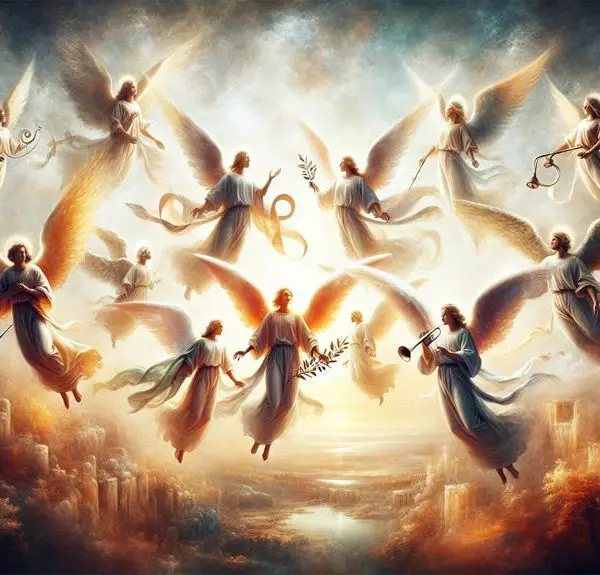
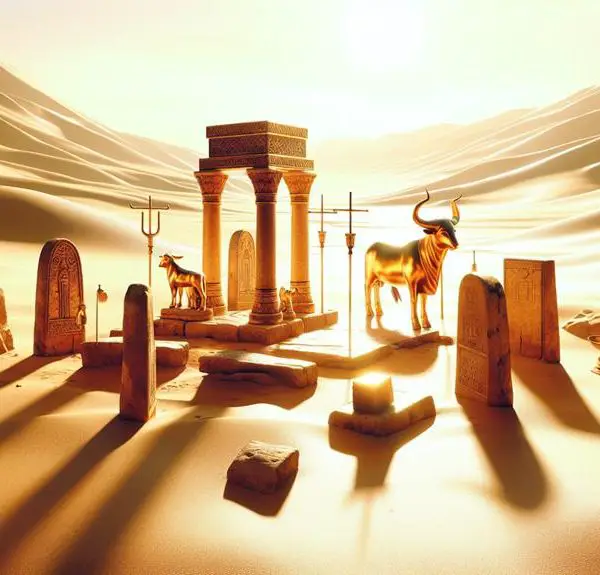
Sign up